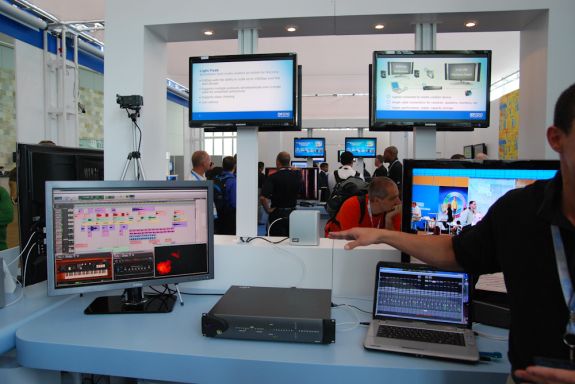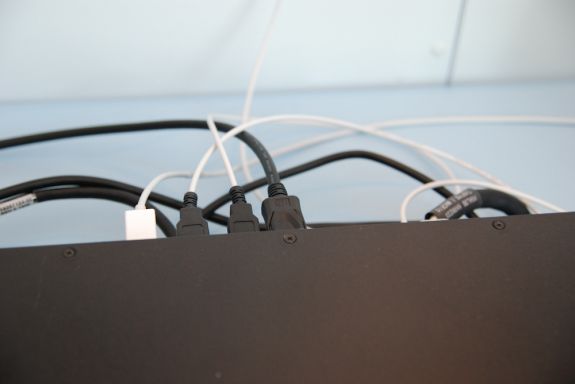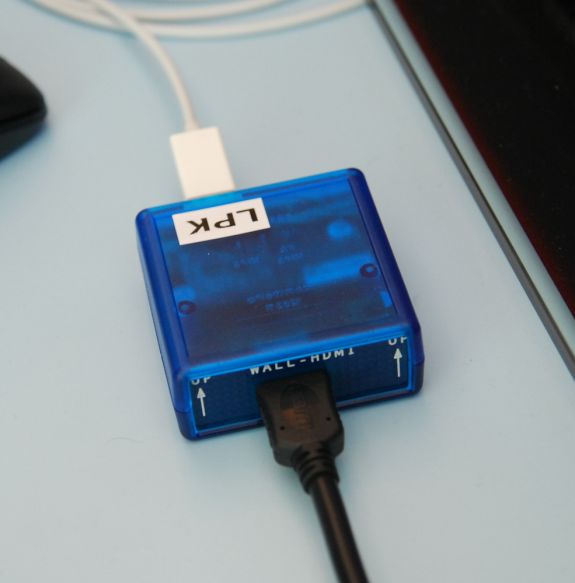Intel Light Peak - Lighting up 10 Gbps links in 2011
by Brian Klug on September 16, 2010 3:40 PM EST- Posted in
- Trade Shows
- Intel
- LightPeak
First off, Light Peak speeds remain the same as we've previously seen at 10 gigabits/s, though opportunity to scale to 100 gigabits/s remains a promise for the future. Intel had two demonstrations setup illustrating Light Peak's potential as a bus for huge amounts of traffic. First up was a Compal notebook connected to an Avid HD I/O box, which was in turn connected to two more devices. An external Western Digital dual drive solution with a Light Peak connector, and an HDMI adapter driving 1080P video content.
According to Intel, Light Peak enabled Avid to move mixing control to the Compal notebook software suite. Bandwidth is now sufficient to pass uncompressed extremely high sampling rate audio streams between the notebook and the Avid HD I/O box.
All of those white cables coming out of the Avid box on the left side are Light Peak. Note that they look a lot like USB - more on that in a moment. Light Peak connects the Avid HD I/O box and its lossless audio streams, a raw 1080P HDMI video stream, Western Digital external hard drive, and another uncompressed video played back on the Dell LCD to the left in this demo. This demo is clearly targeted at selling studio artists on Light Peak.
The Light Peak to HDMI converter box has also shrunk considerably. It's now a bit smaller in profile than a credit card:
There's no external power adapter here either, just Light Peak to HDMI for the TV. The Compal notebook has been shown around a bit before, but the connection is again seamlessly integrated into the notebook by all appearances. Check out the gallery for all the pics from this demo:



















59 Comments
View All Comments
digitaldreamer - Thursday, September 16, 2010 - link
What's the story on ATA? Or, is that assumed to be included as part of the other protocols?MAJ
digitaldreamer - Thursday, September 16, 2010 - link
And, what protocol was used for the external hard drive? USB?MAJ
<wishing for a EDIT option>
jordanclock - Friday, September 17, 2010 - link
ATA is in. USB is in. Any protocol is in. It's up to the device to determine the protocol. You could have external drives using SCSI, USB, or something of their own proprietary design. That's the biggest point of LP: It doesn't care how you organize your bits, it just wants to get them there fast.Mike1111 - Thursday, September 16, 2010 - link
All the LightPeak prototypes seem to have two optical fibers. Wouldn't that mean 20 Gbit/s in each direction?SimKill - Thursday, September 16, 2010 - link
I think its bidirectional, i.e. one for Transmit and one for Receive.So each line would still have only 10Gbps
J_Tarasovic - Thursday, September 16, 2010 - link
Nice work. I am pretty excited about the technology. Still waiting on some SSD news though.DigitalFreak - Thursday, September 16, 2010 - link
I was beginning to think someone from DailyTech snuck an article in. :0)pesos - Thursday, September 16, 2010 - link
could this finally boot expensive fiber channel and provide an inexpensive method for enterprise SAN connections at a far lower cost than FC or 10gbe iscsi?AnnonymousCoward - Thursday, September 16, 2010 - link
The goals that this is set to achieve are:1. 300ft point-to-point cables
2. One cable type for multiple protocols
So...who cares? Repeaters or wireless can already give us cables as long as we want. And what's the point of 1 cable type for all devices? This won't reduce the number of cables involved, it just means 1 type. I don't care what type connects my PC to my monitor, do you? I also think Intel's claim that this lowers cost is bunk, since this means you'll need Light Peak bridges all over the place to convert to our established protocols. That also means that every component would need to adopt it, which won't happen anytime soon.
And why get light involved? If you want a single cable with tons of bandwidth, just use multi-lane PCIe. That'd probably be a lot cheaper, too. USB3 is like 1 lane PCIe2, and they probably could have made it more lanes, but that would increase the cost for unnecessary bandwidth.
I'm with ya, JoKeRr. Apple's pushing it cuz it's "oooo, light" and their next big idiotic marketing thing.
Best Buy charges $230 for a 6.6ft HDMI cable. Who wants to pay $10,000 for a 300ft optical?
zodiacfml - Thursday, September 16, 2010 - link
Aside for having one type of cable to most devices, fiber optics is just the way to go for more bandwidth rather than making more copper lines/wires.One thing I would agree on is this won't make it mainstream in the near future. USB 3.0 is hugely fast for almost all devices and provides electricity to a device, yet I could see Light Peak being used for display connections, HD cameras, external drives in one or two years.